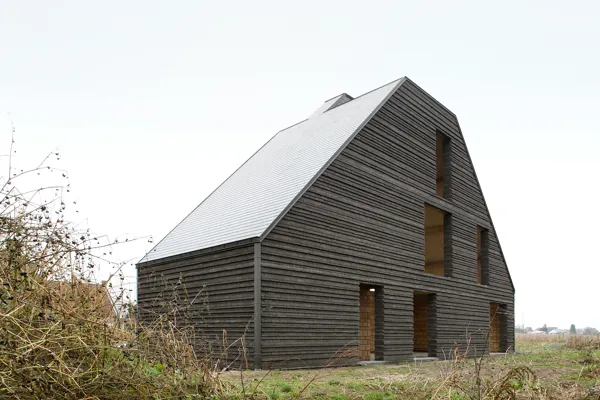Facing brickslinea7 7021
Technische informatie
- Kleur omschrijving
- The bricks are through-coloured and the colour is anthracite brown.
- Afmeting (L x B x H)
- ca. 240x73x38 mm (LxBxH)
- Aantal / m² met een traditionele voeg
- 80 (12 mm)
- Aantal / m² met een dunne voeg
- 93 (6 mm)
- Afmeting 2
- ca. 240x115x38 mm (LxBxH) - on demand for projects > 2000m²
linea7 7021
Anthracite slim brick
This dark, evenly sanded, thin moulded brick carries our ecological ECO-7-size label and it is also part of our Kaliber series. Besides having an elegant appearance, this slender variant from our linea series also leaves more room for insulation or living space. Just like all the bricks from our linea series, it is ideal for accentuating clean lines.
reportage linea7 7021

Budget-friendly housing with a strong element of decorative brickwork
3 formats of brick contribute towards this characteristic, raised façade
For the design of this building, which is situated in a rural area, the architects had to contend with a tight budget. In order to reduce construction costs, they proposed limiting the surface area of the project and also keeping the level of intervention by subcontractors to a minimum.

Dark coloured facing brick Linea 7021 strongly relates to the brand of the legendary Hendrick's Gin
The extraordinary remake of the Hendrick’s Gin Palace in Scotland
The famous Hendrick’s Gin Distillery is located on the South-West Coast of Scotland. Michael Laird Architects along with the Design Team were commissioned to design a purpose-built distillery for Hendrick’s Gin of William Grant & Sons.

Dark facing bricks as a basis for compact yet spacious Toronto home
Mix of two diverse looks make one
The Westminster Residence, located in Toronto’s High Park neighbourhood, reinvents the traditional Edwardian gable home. The exterior showcases a composition of three dark monolithic figures: a low dark brick clad volume, a heavy triangular stone clad roof and tall rectilinear dormers.
Lees verder
Referenties
Verwerkingstips
Preparation of the construction site
- Always order the full amount of bricks required for a specific site. In this way, the entire order can be made during one production run.
- Try to have the full order supplied at one time. If this creates several deliveries, always mix a number of packs from the previous delivery with a number of packs from the new delivery. This procedure is especially recommended in case of re-order or for an additional order.
- Take bricks diagonally across the pack.
- Draw and use bricks from at least five different packs.
- For setting out, use bricks from the delivery made to the site in question. Do not exclusively use the theoretical dimensions of the brick, or samples previously supplied, or different production run from that intended for the site.
- As soon as the bricks arrive on site, check delivery tickets and certificates against the specification and order. Also check that there are no visible inconsistencies with the order.
- Do not lay bricks in freezing weather or protect the ‘fresh’ masonry with insulating mats in order to avoid frost damage to the mortar.
- In the case of prolonged dry hot weather, lightly dampen the newly laid brickwork to stop the mortar drying and curing too quickly.
- Do not lay bricks in precipitation in order to prevent mortar from running on the wall.
Avoid Efflorescence
- During and after laying, protect the newly built brickwork for a height of at least 60 cm - but ensure there is airspace between the brick face and the waterproof covering.
- Provisionally install rainwater down pipes to avoid saturation of the newly laid brickwork
- Never lay bricks in driving rain conditions
























